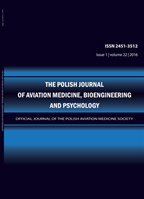2014, Volume 20, Issue 2
Analysis of Relationship Between Oculomotor and Pseudoseizure Activity in EEG Examinations of Aviation Personnel
Jan S. Miszczak1, Stanisław Dec1, Ewa Zalewska2
-------------------------------------------------------------------------------------------------
1Department of Neurology, Military Institute of Aviation Medicine
2Department of Neurology, Institute of Biocybernetics and Biomedical Engineering Polish Academy of Sciences
Autor korenspondencyjny: Jan S. Miszczak; Department of Neurology, Military Institute of Aviation Medicine; email: jmiszczak[at]wiml.waw.pl
Full text
Streszczenie
Introduction: Electrooculographic (EOG) activity recorded simultaneously with the EEG signal is the most common artifact which may be eliminated from EEG records by special algorithms applied in the recording systems. The objective of this study was to identify potential relationships between the activity caused by involuntary eye movement and the spontaneous activity of the brain. A hypothesis was proposed with regard to a potential relationship between interoceptive (central) and exteroceptive (peripheral) mechanism of EOG activity and pseudoseizure episodes in EEG records of healthy subjects.
Method: EEG, VEOG (vertical electrooculographic) and HEOG (horizontal electrooculographic) activity was recorded using a Neuroscan 4.3 system for neurophysiological examination with 1 kHz sampling frequency and 16-bit amplitude resolution. The records were made in line with the recommendation of the International Federation of Clinical Neurophysiology. The study group consisted of 30 healthy subjects aged 24-32 years. A total of 10 records with EOG artifacts were selected for the analysis. The signals were analyzed in the bands of 0.1-4 Hz, 4-8 Hz, 8-14 Hz, and 0.1-70 Hz using FFT, Intra-Class Correlation coefficients and coherence ratios.
Results: The results showed a significant variability of the amplitude and frequency of the episodes of EOG activity simultaneous to EEG oscillations in various areas of the brain. The highest impact of EOG on the EEG record was observed in the frontotemporal region. The coherence ratios for signals recorded in the mediotemporal region was 0.56-0.67 (delta) and 0.8-0.95 (theta) compared to <0.99 in the frontal region. Simultaneous EOG oscillations and pseudoseizure-type EEG activity were observed in 3 records.
Discussion: The characteristics of oscillations of bioelectrical activity in various regions of the brain correlated to EOG activity in records taken with subjects' eyes open is different than in records taken with subjects' eyes being closed. The EEG records are indicative of a relationship between the central and peripheral neuronal mechanism of eye movements and the brain activity in various frequency bands. The results are suggestive of a potential impact of oculomotor activity on the recorded EEG oscillations. Therefore, interpretation of generalized oscillation episodes in healthy subjects requires the analysis of the morphology and dynamics of oscillations as well as of the simultaneous EOG activity.
Conclusions: Differentiation of pseudoseizure and seizure episodes requires oculomotor activity being recorded using an extended protocol with eyes both open and closed in order to verify the impact of oculomotor activity on EEG records.
Słowa kluczowe
EEG, oculomotor activity, aviation medicine, VEOG, HEOG
